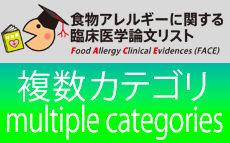Pediatric sublingual immunotherapy efficacy: evidence analysis, 2009-2012
更新日:2016年10月21日
| Author: | Larenas-Linnemann D, Blaiss M, Van Bever HP, Compalati E, Baena-Cagnani CE. |
|---|---|
| Title: | Pediatric sublingual immunotherapy efficacy: evidence analysis, 2009-2012. |
| Citation: | Annals of allergy, asthma and immunology 2013 Jun;110(6):402-415.e9. |
| URL: | https://pubmed.ncbi.nlm.nih.gov/23706708/ |
| Abstract: | OBJECTIVE: To perform a structured analysis of the latest scientific evidence obtained for the clinical efficacy of sublingual immunotherapy (SLIT) in children. DATA SOURCES: PubMed, Embase, reference lists from reviews, and personal databases were reviewed for original articles on clinical trials with SLIT in patients younger than 18 years published from January 1, 2009, through December 31, 2012, using broad search and medical subject heading terms. STUDY SELECTIONS: Clinical trials, irrespective of their design, of SLIT in the treatment of respiratory and food allergy in patients 18 years or younger were selected. Clinical outcomes (symptom scores, medication use, provocation tests, pulmonary function tests, skin prick tests, and adverse events) and immunologic changes were tabulated. Quality of each trial and total quality of compounded evidence was analyzed with the Grading of Recommendations Assessment, Development and Evaluation system. RESULTS: Of 56 articles, 29 met the inclusion criteria. New evidence is robust for the precoseasonal tablet and drop grass pollen SLIT efficacy in allergic rhinitis and scarce for seasonal asthma. Some evidence for Alternaria SLIT efficacy is appearing. For house dust mite (HDM) SLIT in asthma, there is high-quality evidence for medication reduction while maintaining symptom control;evidence for HDM SLIT efficacy in allergic rhinitis is of moderate-low quality.There is moderate evidence for efficacy of dual grass pollen-HDM SLIT after 12 months of treatment and 1 year after discontinuation. Specific provocation test results (nasal, skin) improve with grass pollen and HDM SLIT but nonspecific bronchial provocation testing does not. Food oral immunotherapy is more promising than food SLIT. Possible new surrogate markers have been reported. No anaphylaxis was found among 2469 treated children. CONCLUSION: Evidence for efficacy of SLIT in children with respiratory or food allergy is growing. |
| 邦文タイトル: | 準備中 |
| 一般向け要約 | 準備中 |
| 専門医コメント | 準備中 |


